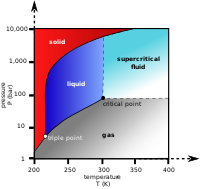
Photo from wikipedia
Abstract Late Ordovician – Early Silurian bentonites and shales are widely distributed in the western Yangtze plate, South China. This study is to use these rocks to examine the mechanism of… Click to show full abstract
Abstract Late Ordovician – Early Silurian bentonites and shales are widely distributed in the western Yangtze plate, South China. This study is to use these rocks to examine the mechanism of global cooling. We present total organic carbon content (TOC) and organic carbon isotope data. The TOC of the shales for the Qiliao (QL) and Shuanghe (SH) sections range from 0.21% to 5.88% with an average of 3.0%, and from 1.48% to 6.34% with an average of 2.91%, respectively. The organic carbon isotopic compositions of the shales from the QL and SH sections are 31.1‰–29.4‰ (average 30.3‰) and −30.8‰–29.1‰ (average 30.0‰), respectively. In combination with previous studies of the Katian to Hirnantian glaciation, two conclusions can be summarized: (1) shales in close proximity to volcanic ash (bentonite) layers exhibit obvious TOC reduction, which indicates that the deposition of volcanic ash inhibited the productivity of marine plankton; (2) the organic carbon isotope compositions of shales close to volcanic ash layers present positive excursions, reflecting the decline of the atmospheric carbon dioxide after the volcanic ruption. The main reason is probably that the intense volcanic eruptions created abundant volcanic ash for weathering. It is probably 840 × 1015 kg (1.9 × 1019 mol) carbon dioxide was consumed in the process of volcanic ash weathering, this would make the carbon dioxide content of the atmosphere drop to the threshold level, which triggered the global glacial event during the Early Hirnantian stage, and then the Earth entered into an ice age in the Late Ordovician. Therefore, this study provides a new point of view to understand the climate variation in the Earth's geological evolution history.
Journal Title: Journal of Asian Earth Sciences
Year Published: 2020
Link to full text (if available)
Share on Social Media: Sign Up to like & get
recommendations!